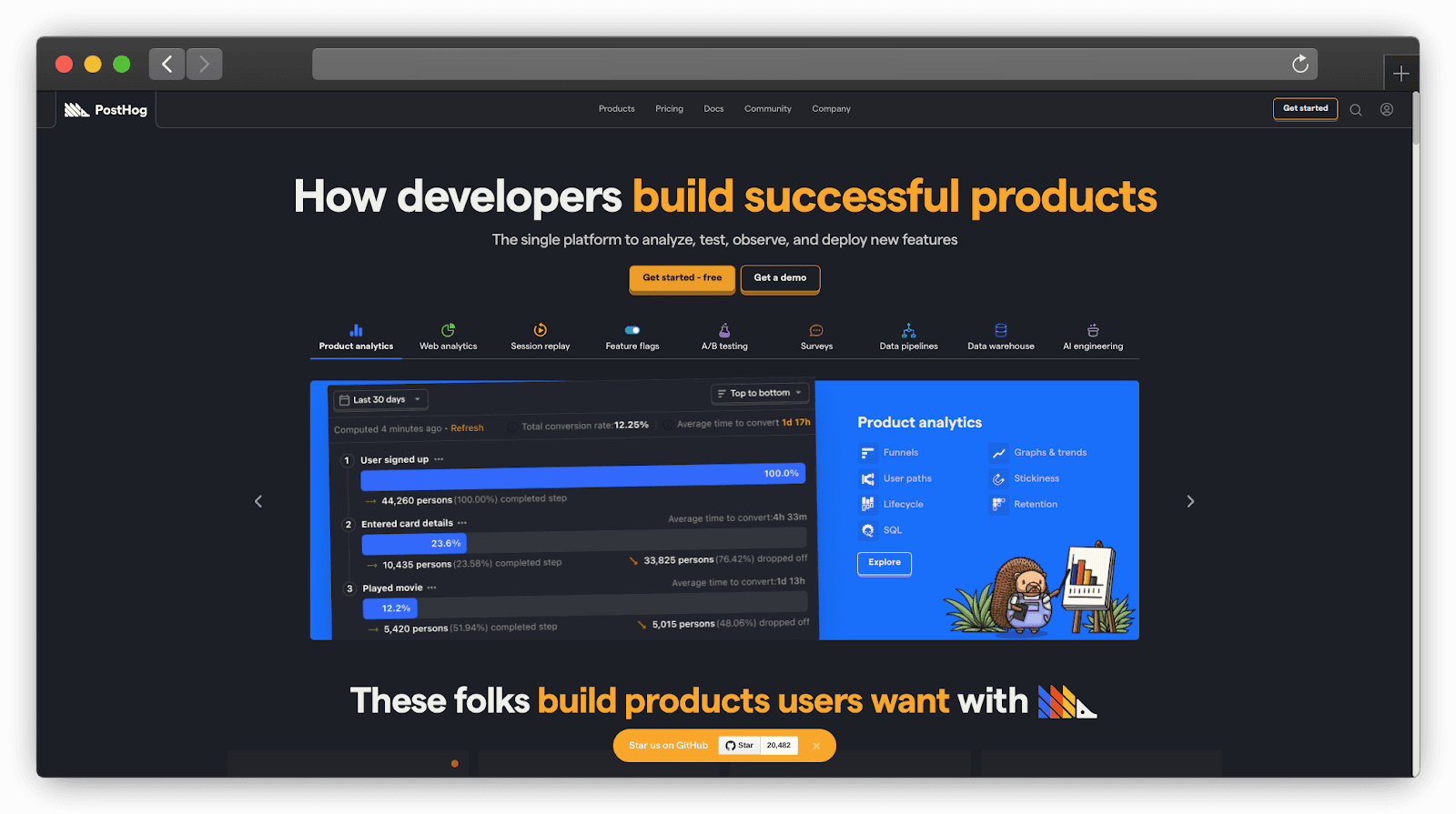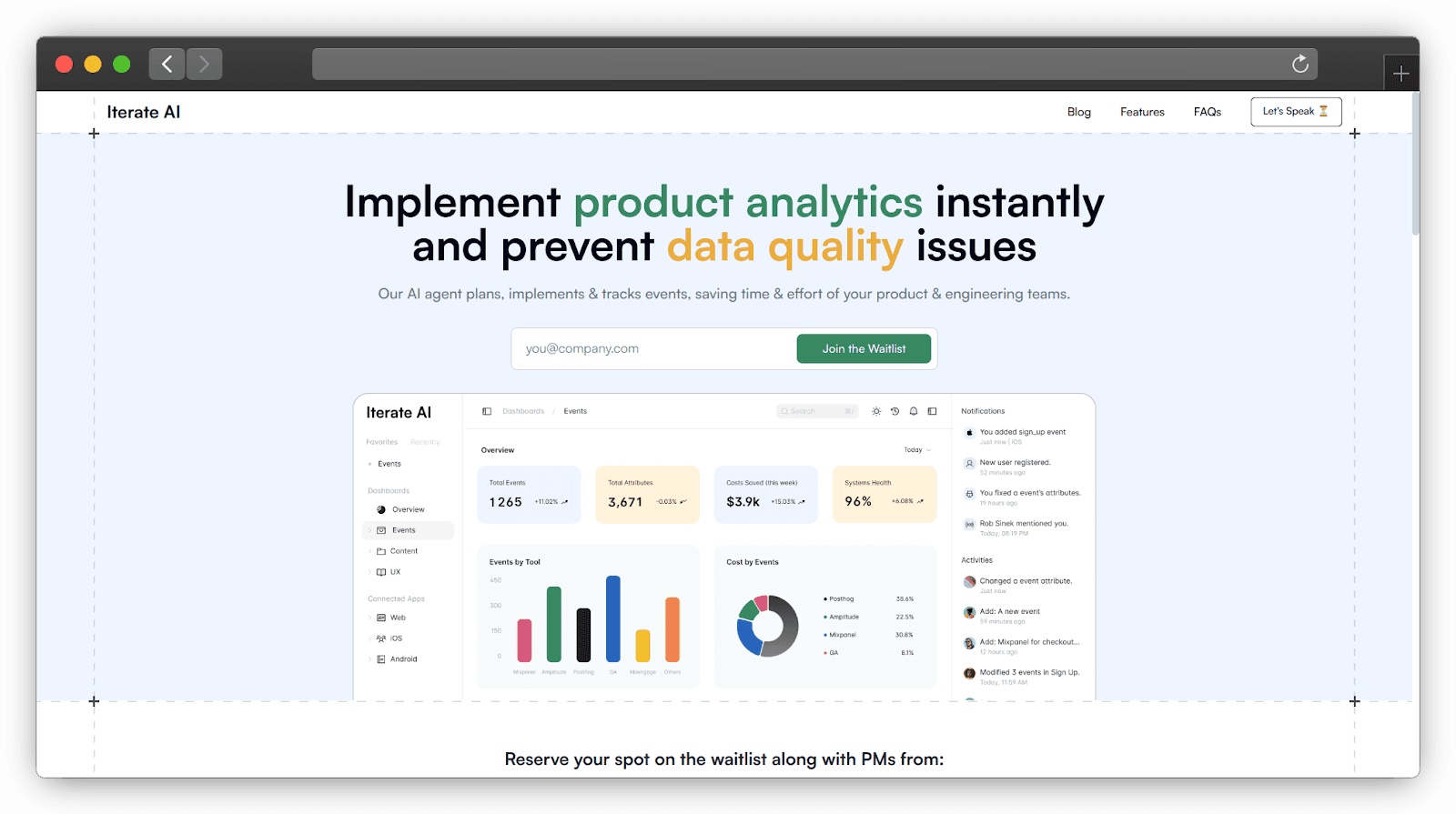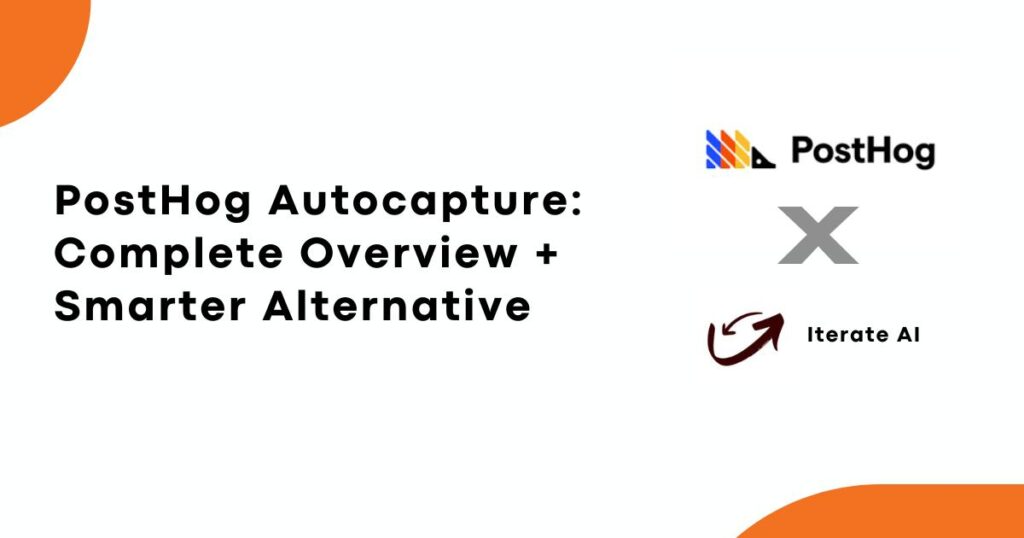
Iterate AI
Sep 3, 2024
If you are into the world of Product Analytics you must have encountered PostHog and its popular Autocapture feature. This powerful tool will help you upgrade how you collect user behavior data, but is it the best solution in the market?
In this simple guide, we will go through the PostHog's Autocapture feature and learn about a smarter alternative to PostHog.
Let's dive in.
Understanding PostHog Autocapture
PostHog Autocapture is a powerful feature that automatically captures frontend events in web applications without requiring a manual tracking code for every interaction. It simplifies the process of implementing product analytics, allowing teams to quickly start capturing and analyzing user data.
With Autocapture, you can track a wide range of user interactions, including clicks, form submissions, page views, and more.
Types of Auto Captured Events in PostHog
Page views and leaves
Clicks on interactive elements
Form submissions
Rage clicks
Mobile screen interactions
These are the types of events that help brands understand user behavior to another level, enabling teams to make data-driven decisions.
Setting Up and Configuring PostHog Autocapture
Implementing PostHog Autocapture
The fastest way to set up autocapture is to copy the snippet below and paste it into your site’s HTML in the <head> tags. This should be an HTML page that acts as a base or template page (with other scripts your page loads) to ensure all possible events are captured.
As you do this, Autocapture is enabled by default. This will automatically track various user interactions, including page views, clicks, and form submissions, without needing to set up individual events manually.
Alternatively, Autocapture is available on JavaScript, React, and React Native SDKs as well.
Configuring Posthog Autocapture
If you want to limit the types of events captured, you can configure the Autocapture settings.
Reducing events with an allowList and ignoreList:
You can disable Autocapture by setting it to false in the code:
Setting autocapture: false in the PostHog initialization code disables the Autocapture feature entirely for that particular instance of PostHog. This means that no user interactions will be automatically tracked on any pages where this configuration is applied.
It's important to note that disabling Autocapture does not affect any custom events you have set up using the posthog.capture() function. Those events will still be tracked as configured, regardless of the Autocapture setting.
You can also avoid capturing sensitive information, by using the ph-no-capture class on any HTML elements you want to exclude from tracking.
Enable clipboard autocapture to track text users copy or cut
Add custom properties to elements using data-ph-capture-attribute
While PostHog's Autocapture feature is a convenient way to start tracking user interactions, it has some gaps, let’s discuss.
Gaps In Autocapture
As we saw above autocapture is a powerful feature that simplifies the process of tracking users, but it has multiple gaps. Amplitude, a popular digital analytics platform didn't build this autocapture feature, due to these gaps.
Data Overload
As it captures crazy large information it will quickly become overwhelming to analyze all. These data will shift your focus and let's assume you analyzed the vast data too, imagine the time spent on it only to discover that much of it is irrelevant to your goals.
Requires Customization
As autocapture follows a one-size-fits-all approach which means you will end up tracking interactions that don't align with your goals. This means capturing too much data and missing some critical data events too.
Frontend Only
PostHog's Autocapture, client-side tracking may miss events. Iterate's server-side tracking captures interactions reliably without performance issues.
For a deeper exploration of the challenges associated with autocapture, including insights from PostHog, you can read more in their blog post here.
Iterate AI - Alternative to PostHog Autocapture
Iterate AI, on the other hand, is a tool that automates the process of tracking custom events (and to any destination tool like Mixpanel, Amplitude, PostHog), without doing any kind of auto-capture.
Designed for modern product teams, it uses artificial intelligence to streamline how user interactions are monitored within applications. Instead of the traditional manual coding of tracking events, IterateAI allows teams to specify key features and metrics they wish to observe, while the AI takes care of the rest.
Saves time and minimizes the risks of human error.
How Iterate AI Enhances PostHog’s Autocapture
While PostHog offers an Autocapture feature that we discussed above, IterateAI elevated this concept with a more user-friendly approach.
Here is how Iterate AI enhances the experience:
Smart Event Tracking: Product Managers can easily define the metrics that matter most to them. The AI agent then generates a tailored list of events and attributes to track, eliminating the tedious task of manual tracking code insertion for every interaction.
Seamless Code Integration: The platform integrates tracking code directly into your existing codebase, automatically creating pull requests for engineers to review. Without breaking the dev workflow this ensures that the tracking is implemented smoothly.
Customizable Tracking Parameters: PMs can easily customize tracking parameters without needing extensive coding knowledge. This flexibility allows teams to adapt their tracking strategy as product features evolve.
PostHog Autocapture vs. Iterate AI
So here we are choosing between PostHog Autocapture and Iterate AI for your automated analytics and event tracking needs. Both offer great features and cater to different requirements.
A simple breakdown.
PostHog AutocaptureIterateAIPredefined set of events are auto captured. Product Managers can define the events required in natural language.Custom events are created by developers. Custom events can be written directly by the Product Manager and not rely on developers. PostHog Auto Capture integrates with PostHog.IterateAI integrates with popular platforms like Mixpanel, Amplitude, and Posthog.Developer-centric, may require technical knowledge.User-friendly, designed for product managers.PostHog Autocapture works only for front-end events.IterateAI currently supports front-end events with back-end events support coming soon.
Which one is right for you?
It depends on your particular use case.
PostHog Autocapture

PostHog is a great choice if you want a comprehensive analytics platform that captures user interactions automatically. Its Autocapture feature allows you to quickly gather data without any extensive setup.
However, this convenience comes with risks, such as potential PII data leaks and the possibility of capturing excessive or irrelevant events. Furthermore, there can be challenges with ensuring that the properties you want to track are captured accurately.
If your team consists of engineers and product managers who can handle some data cleanup and are looking for a tool that integrates multiple functionalities (like A/B testing and session replay), PostHog could be the right fit for you.
Iterate AI

On the other hand, Iterate AI is great, where precision and data integrity are at the top. While it requires product managers to label events, this process ensures that only relevant data is captured, minimizing the risk of redundancy.
This approach can feel like having an extra developer focused on event tracking, which can be beneficial for teams that prioritize clean data over quick setups.
If your organization is focused on AI-driven applications and needs a platform that minimizes unnecessary interactions while providing reliable insights, IterateAI is likely the better choice.
Conclusion
Both PostHog and Iterate AI offer valuable features, but they cater to different approaches and needs. PostHog provides a hands-off autocapture experience, while IterateAI emphasizes precision and control in event tracking.
If your team is looking for a solution that minimizes redundancy and enhances data accuracy, IterateAI is an excellent choice. By empowering product managers to label events and automate the tracking process, it acts as an extra developer for event tracking.
Ready to streamline your event tracking and unlock the full potential of your product analytics? Sign up for Iterate AI today and experience the difference for yourself!
Bonus: Download 10+ Free Tracking Plan Templates for Mixpanel, Amplitude, and More
